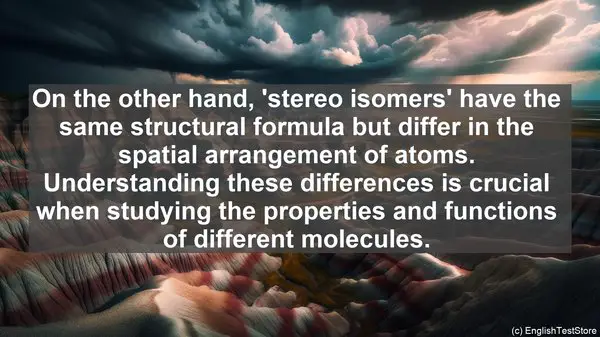Introduction: The Importance of Language in Biochemistry
Welcome to today’s lesson on the top 10 commonly confused words in comparative biochemistry. While the world of biochemistry is fascinating, it can also be quite complex. And one aspect that often adds to this complexity is the language we use. The field is filled with terms that sound similar but have distinct meanings. Understanding these differences is not just about semantics; it can have a significant impact on our research and findings. So, let’s dive in and explore these words in detail.
1. Homologous vs. Analogous
One of the first pairs of words that often cause confusion is ‘homologous’ and ‘analogous.’ While both terms refer to similarities, they are used in different contexts. ‘Homologous’ refers to traits or structures that are similar due to a common ancestry. On the other hand, ‘analogous’ describes traits that have a similar function but not necessarily a common origin. Understanding this distinction is crucial when studying the evolution of organisms or comparing biochemical pathways.
2. Convergent vs. Divergent Evolution
Next up, we have ‘convergent’ and ‘divergent’ evolution. These terms are often used when discussing the similarities and differences between species. ‘Convergent evolution’ occurs when unrelated organisms develop similar traits due to similar environmental pressures. On the other hand, ‘divergent evolution’ refers to the development of different traits in related organisms over time. By understanding these concepts, we can gain insights into how species adapt and evolve in different environments.
3. Isomers: Structural vs. Stereo
Moving on, let’s talk about ‘isomers.’ Isomers are compounds that have the same molecular formula but different arrangements of atoms. In comparative biochemistry, we often come across two types of isomers: ‘structural’ and ‘stereo.’ ‘Structural isomers’ have the same atoms but differ in the way they are bonded. On the other hand, ‘stereo isomers’ have the same structural formula but differ in the spatial arrangement of atoms. Understanding these differences is crucial when studying the properties and functions of different molecules.
4. Genotype vs. Phenotype
When studying the characteristics of organisms, we often come across the terms ‘genotype’ and ‘phenotype.’ ‘Genotype’ refers to the genetic makeup of an organism, the specific combination of genes it carries. On the other hand, ‘phenotype’ refers to the observable traits of an organism, which are influenced by both its genotype and the environment. By understanding the interplay between genotype and phenotype, we can gain insights into how genetic variations manifest in different organisms.
5. Endothermic vs. Exothermic
In the realm of biochemistry, we often encounter reactions that involve the exchange of energy. Two terms commonly used to describe these reactions are ‘endothermic’ and ‘exothermic.’ ‘Endothermic’ reactions absorb energy from their surroundings, while ‘exothermic’ reactions release energy. Understanding the energy dynamics of these reactions is crucial when studying metabolic pathways and the overall energy balance in living organisms.
6. Homozygous vs. Heterozygous
When discussing genetic traits, the terms ‘homozygous’ and ‘heterozygous’ come into play. ‘Homozygous’ refers to a condition where an organism has two identical alleles for a particular gene. On the other hand, ‘heterozygous’ describes a condition where an organism has two different alleles for the same gene. These terms are essential when studying inheritance patterns and the likelihood of certain traits being expressed in offspring.
7. Catabolism vs. Anabolism
Next, let’s explore the terms ‘catabolism’ and ‘anabolism.’ These words are often used when discussing metabolic processes. ‘Catabolism’ refers to the breakdown of complex molecules into simpler ones, often accompanied by the release of energy. On the other hand, ‘anabolism’ describes the synthesis of complex molecules from simpler ones, requiring an input of energy. Understanding the balance between these two processes is crucial when studying the overall metabolism of an organism.

8. Eukaryotes vs. Prokaryotes
When studying the diversity of organisms, we often categorize them into two broad groups: ‘eukaryotes’ and ‘prokaryotes.’ ‘Eukaryotes’ are organisms whose cells have a nucleus and other membrane-bound organelles. On the other hand, ‘prokaryotes’ are organisms whose cells lack a nucleus and other membrane-bound organelles. Understanding these distinctions is fundamental when comparing the cellular structures and functions of different organisms.
9. Transcription vs. Translation
In the realm of molecular biology, two processes that often come up are ‘transcription’ and ‘translation.’ ‘Transcription’ is the process of synthesizing an RNA molecule from a DNA template, while ‘translation’ is the process of synthesizing a protein from an RNA molecule. These processes are essential for gene expression and understanding how genetic information is converted into functional molecules.
10. Primary vs. Secondary Metabolites
Lastly, let’s explore the terms ‘primary’ and ‘secondary metabolites.’ ‘Primary metabolites’ are molecules that are essential for the growth, development, and reproduction of an organism. They include compounds like carbohydrates, proteins, and nucleic acids. On the other hand, ‘secondary metabolites’ are molecules that are not directly involved in these essential processes but often play roles in defense, signaling, or attraction. Understanding the functions of these metabolites is crucial when studying the overall physiology of an organism.

